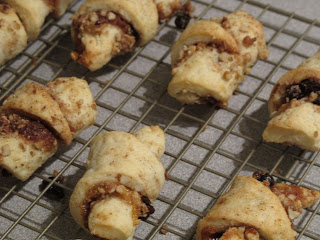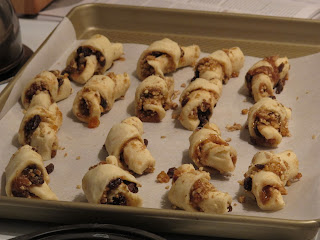 My favorite cookie to materialize during this week was rugelach, a twisty, croissant-like cookie flecked with raisins and nuts, and sweet with apricot jam. Rugelach first appeared in Jewish baking traditions in Central Europe sometime in the 18th or 19th century. The cookie evolved out of the viennoiserie of baked goods that flourished throughout the 19th century in Vienna. Of course I can't resist viennoiserie almost just as much as I can't resist typing it out or thinking about incorporating the concept into my dissertation. Croissants, pain au chocolat, and other twisty, braided sweet goods also fall under the category of viennoiserie. It's a French concept that is derived from Vienna coffeehouse fare that I love so well. Rugelach belongs to the category of viennoiserie because of its croissant-like shape and delicate appeal. Modern rugelach cookies are mostly baked, but some Jewish traditions opt to fry theirs in oil, thereby appropriating this delicious cookie to the season of Hanukkah.
My favorite cookie to materialize during this week was rugelach, a twisty, croissant-like cookie flecked with raisins and nuts, and sweet with apricot jam. Rugelach first appeared in Jewish baking traditions in Central Europe sometime in the 18th or 19th century. The cookie evolved out of the viennoiserie of baked goods that flourished throughout the 19th century in Vienna. Of course I can't resist viennoiserie almost just as much as I can't resist typing it out or thinking about incorporating the concept into my dissertation. Croissants, pain au chocolat, and other twisty, braided sweet goods also fall under the category of viennoiserie. It's a French concept that is derived from Vienna coffeehouse fare that I love so well. Rugelach belongs to the category of viennoiserie because of its croissant-like shape and delicate appeal. Modern rugelach cookies are mostly baked, but some Jewish traditions opt to fry theirs in oil, thereby appropriating this delicious cookie to the season of Hanukkah. Now that I've successfully used viennoiserie in a sentence
Now that I've successfully used viennoiserie in a sentence Even though this recipe requires several steps and multiple chilling times for the cream cheese-based dough, rugelach is actually very simple and quick. Prepare these while you are cleaning your house and packing for Christmas break and you will find that it is in fact a very low-maintenance dessert, both to prepare and to eat.
Rugelach
Adapted from Cook's Illustrated
 2 sticks (16 tablespoons) unsalted butter, cut into cubes and chilled
2 sticks (16 tablespoons) unsalted butter, cut into cubes and chilled8 ounces cream cheese, cubed and chilled
2 1/2 cups all-purpose flour
1 1/2 tablespoons sugar
1/4 teaspoon kosher salt
2 tablespoons milk or half & half
3/4 cup sugar
1 tablespoon cinnamon
2/3 cup apricot preserves
1 cup raisins
1 1/2 cup pecans, chopped fine (walnuts are traditional in this recipe but I had no walnuts, am obsessed with pecans, so there you go)
In a stand mixer, combine flour, sugar, and salt. Add butter and sour cream and mix (with whisk attachment) until incorporated into the flour mixture. The texture should be a bit dry at this point, but the cream cheese and butter should form into little balls about the size of cottage cheese. Add milk and mix until a smooth dough forms.
 Roll dough into a log about 8 inches long and 4-5 inches across. Divide into four equal pieces. With a rolling pin, roll each piece out into a circle, 8 inches in diameter. Place each circle of dough between sheets of parchment paper or waxed paper. Chill for about an hour.
Roll dough into a log about 8 inches long and 4-5 inches across. Divide into four equal pieces. With a rolling pin, roll each piece out into a circle, 8 inches in diameter. Place each circle of dough between sheets of parchment paper or waxed paper. Chill for about an hour.Remove dough from refrigerator; work only with one at a time to preserve the dough's temperature. Spread about 2 tablespoons (or more) over the dough's surface, and follow with about 1/4 cup raisins, 1/3 (or more) cup chopped nuts, and 2-3 tablespoons cinnamon sugar. I find that it's easiest to press this mixture into the dough with the flat part of a knife or the back of a spoon before cutting your rugelach.
Divide dough into 8 equal wedges and roll each wedge up from the wide part to the tip. Roll each wedge as tightly as you can; don't worry if jammy nut mixture spills onto your cutting board. (This is a bit of a messy cookie. At least in my kitchen.) Transfer rugelach to a plate or pan and pop in the freezer for about 15 minutes. In these 15 minutes you can easily finish preparing the other 3 discs of dough.
Bake rugelach on pan with parchment paper at 375 F for 11 minutes. Rotate pan and bake for another 11 minutes. Cool on wire rack. Rugelach may be stored in an airtight container for up to two weeks but I challenge you to let them last that long.


No comments:
Post a Comment